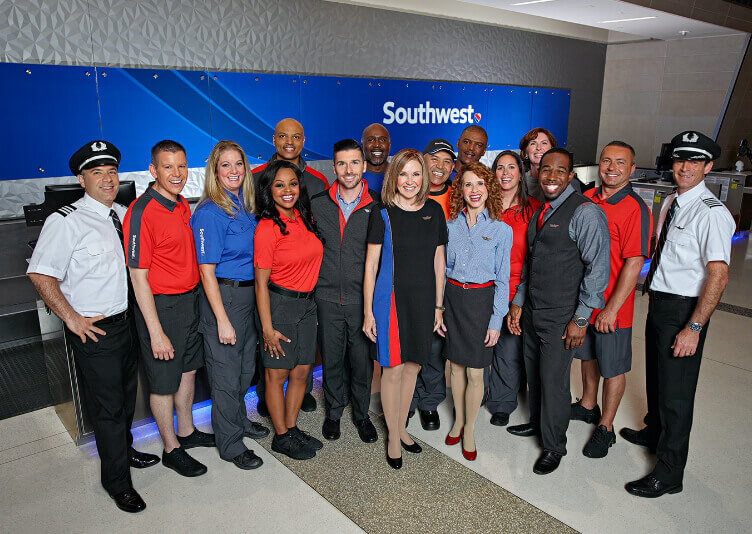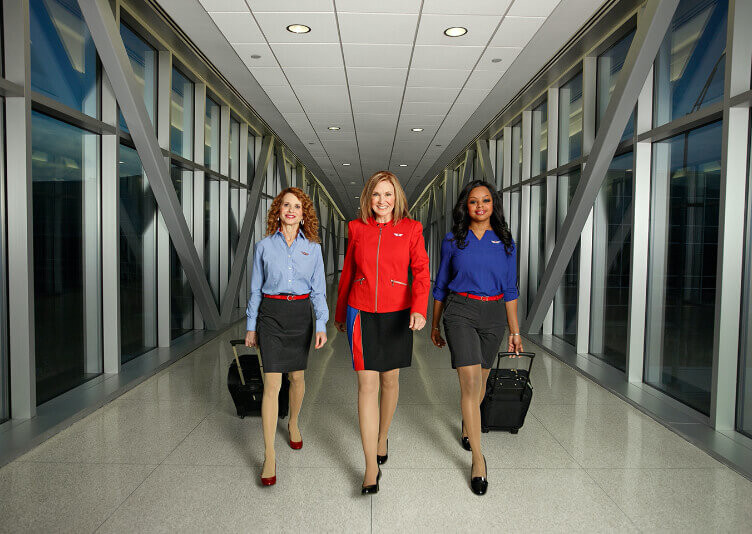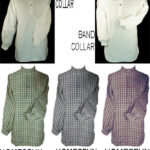The Southwest Airlines visual identity has always been dynamic, and the leadership understood the need for uniforms to reflect this evolution. This led to a significant uniform upgrade project, designed to embody the airline’s fresh and vibrant brand, especially for frontline employees like flight attendants.
The previous uniforms, introduced in 1996, had served their purpose effectively. The relaxed polos and casual pants communicated a sense of ease and approachability, perfectly aligning with Southwest’s “unstuffy” image. Passengers felt a sense of comfort, mirrored by the comfortable appearance of the employees. However, times change, and brands evolve.
Sonya Lacore, Vice President of Inflight Operations and a former Flight Attendant herself, spearheaded the uniform refresh with a clear vision: to send an equally powerful, yet modern message. Her approach was groundbreaking. Instead of imposing top-down design mandates, Lacore prioritized unprecedented input from Southwest Employees, the very people who would wear the uniforms daily.
“Working in the air and on the ground requires movement – stretching, bending, lifting,” Sonya Lacore explained. “Sometimes, there’s a disconnect between what looks stylish and what feels practical. I truly believed we could achieve both – stylishness and comfort. And I knew the key was to actively involve our Frontline Employees in the design process.”
This commitment to a democratic design process initially surprised some design agencies, particularly those accustomed to shorter uniform lifecycles. However, Southwest remained steadfast in its employee-centric philosophy. Their response to agencies hesitant about extensive employee input was clear: “We have our own designers. They’re called our Employees.”
From that point, progress was rapid. Southwest partnered with a suitable design firm and assembled a diverse Employee Design Team of 43 members. Diversity was paramount – representing various departments, body types, heights, ethnicities, genders, and fashion preferences.

One of the key considerations in designing the new Southwest Airlines uniform was ensuring versatility and functionality across the diverse roles within the Southwest family, from flight attendants to ground crew.
The design team embarked on an inspiring research trip to Chicago, exploring retail trends and gathering ideas. Passionate discussions followed, with team members meticulously analyzing the pros and cons of different design concepts.
Southwest aimed for versatility, ensuring employees weren’t limited to a single uniform style. Every idea – cuts, colors, and concepts – was open for debate.
Bow ties? Generally not a fit for Southwest, especially for ground staff. Shorts? Keep them, but redesign for a more athletic, contemporary look. Color schemes? A challenging decision. Charcoal grays and blacks offered sophistication, while bolder primary colors resonated with Southwest’s vibrant brand.
Through numerous meetings, the team refined their vision, establishing core design principles – a “sliding scale consensus”: Professional, but approachable. Fun, but not gimmicky. Casual, but polished.
This framework paved the way for an exciting new uniform catalog. The collection included shorts, pants, polos, blouses, a skirt, and two dress options – a total of 75 mix-and-match pieces. The color palette and design details were particularly impactful. Blues and reds, inspired by Southwest’s aircraft liveries, were incorporated as sleek stripes on dress hemlines and polo shoulders, injecting brand identity into the fabric itself.
Extensive work continued throughout 2015 and 2016. Once fabrics were selected, Southwest sent team members to visit factories overseas, ensuring ethical labor practices and alignment with the company’s values. Early uniform prototypes were then distributed to 130 employees for real-world wear testing and feedback.

The new Southwest Airlines flight attendant uniform, with its bold color accents and familiar Southwest hues, perfectly embodies the airline’s brand essence.
“We conducted thorough wear-testing to guarantee comfort and functionality,” explained Flight Attendant Tracye Tipps, a member of the Design Team. “This testing spanned across various employee groups to ensure broad satisfaction and practicality.”
Sonya Lacore and her team were meticulous in gathering feedback. They wanted to know everything: colorfastness after washing, performance in varying temperatures, and stain resistance. Some pieces excelled, while others required adjustments based on real-world performance.
By early 2016, the team knew they had achieved their goal. They organized a fashion show in Dallas for Chairman and CEO Gary Kelly and other Southwest leaders. The event featured a red carpet, music, and an atmosphere of anticipation.
Initial nerves quickly dissipated as Design Team members showcased the new uniforms. Leadership rose to their feet, applauding and cheering with genuine enthusiasm.
One model, a Southwest Mechanic who had initially been hesitant, approached Sonya Lacore after the show, tears in her eyes. “I can’t believe it,” she said. “I never imagined I’d ever walk a red carpet.”
When Southwest Employees officially began wearing the new uniforms in June 2017, a wave of pride resonated throughout the company. Three years of dedicated work had culminated in a resounding success. From every stitch to every detail, the uniforms were authentically Southwest – approachable yet professional, comfortable yet chic, striking and personable.
These uniforms were not designed to merely impress customers or chase fleeting fashion trends. They were created to instill pride in the People of Southwest, enhancing how they felt and presented themselves every day. For a Southwest Airlines flight attendant, donning this uniform was about more than just clothing; it was about embodying the spirit of the airline.
“This experience taught me a valuable lesson,” Sonya Lacore reflected years later. “I knew uniforms were important, but I didn’t realize just how important. When employees look good, they feel good. And that feeling is incredibly powerful.”

